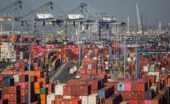Johannah Bernstein post: "eternally proud of my father’s extraordinary aeronautical engineering. legacy. here is a photo of the Canadair Water…
Trump Tariffs & Trade 2024- 14 April 2025
Written by Diana Thebaud Nicholson // April 14, 2025 // Economy, Trade & Tariffs, U.S. // Comments Off on Trump Tariffs & Trade 2024- 14 April 2025
24 November 2021
Trump Wanted to Punish China.
We’re Still Paying for It.
14 April
Tariffs are Hitting Aircraft makers (video)
New tariffs are looming over the global aircraft manufacturing industry. So, what happens when trade politics meets the world’s most interconnected supply chain? The consequences for American aviation and the world could be far more serious than you think
Capt. Petter Hornfeldt discusses the effects of the US tariffs on the American aerospace industry – with an obvious concentration on Boeing Commercial Aircraft, the parts sector and the US aero-engine firms, GE and Pratt & Whitney. He explores the complex global supply chains and the effects of the tariffs on how aircraft are designed, built, sold and supported in the market throughout their lives (which can be 30-50 years).
Trump Floats Temporary Reprieve for Autos as Parts Tariffs Loom
(Bloomberg) President Donald Trump said he is exploring possible temporary exemptions to his tariffs on imported vehicles and parts to give auto companies more time to set up US manufacturing.
“I’m looking at something to help car companies with it,” Trump told reporters Monday in the Oval Office. “They’re switching to parts that were made in Canada, Mexico and other places, and they need a little bit of time, because they’re going to make them here.”
13 April
Peter Navarro says U.S. ‘has no defense other than tariffs’: Full interview
(NBC Meet the Press) In an exclusive interview with Meet the Press, White House trade adviser Peter Navarro defends President Trump’s evolving tariff strategy as he escalates a trade war with foreign allies and adversaries.
Peter Navarro, Sen. Cory Booker and Ray Dalio
President Trump reverses course tariffs — pausing most hikes but raising them on China, while exempting key tech imports. Trump’s top trade adviser Peter Navarro, Sen. Cory Booker (D-N.J.) and billionaire investor Ray Dalio join Kristen Welker with exclusive reactions.
10 April
Why Trump Unleashed Tariff Chaos
In this Bloomberg Originals weekly documentary, we unpack Donald Trump’s reasons for the trade war and whether it can accomplish his goals.
Trump believes his tariff strategy will position the US for a “golden age” of growth after some short-term pain, and that it will level the playing field, attract new industrial jobs, and rake in trillions of dollars in levies.
… In Why Trump Unleashed Tariff Chaos, we also explain how the cost of such levies—essentially an import tax—are usually passed on to consumers and fuel inflation. Simultaneously, higher prices cause those consumers to stop buying, which in turn diminishes the tariff revenue flowing in. More broadly, and as many economists have predicted, the worst case scenario is a recession—not only for the US, but the entire world.
9 April
Ian Bremmer: America just entered its post-globalization era
… Faulty math, faulty logic
Trump had described the “liberation day” tariffs as “reciprocal,” saying that the United States is only doing onto other countries as they do to the US. But the formula the administration ended up using doesn’t consider the tariff rates and nontrade barriers other countries impose on US exports at all. Instead, the calculation assumes that bilateral goods trade deficits are necessarily and entirely “unfair,” representing “the sum of all cheating.”
This is a gross misunderstanding of how trade works. There’s no linear correlation between a country’s protectionism and its bilateral trade balances. Bilateral surpluses and deficits reflect all sorts of factors unrelated to trade policy – from population size and wealth to differences in resource endowments and comparative advantages, all the way to idiosyncratic preferences for certain products over others. That’s why there’s nothing inherently bad or unsustainable about bilateral deficits.
In stunning U-turn, Trump walks back some tariffs, triggering historic market rally
In a stunning reversal, U.S. President Donald Trump said on Wednesday he would temporarily lower the hefty duties he had just imposed on dozens of countries while further ramping up pressure on China, sending U.S. stocks rocketing higher.
Live updates: S&P 500 soars 9.5% to one of its biggest gains since WWII after Trump limits some tariffs
(AP) Trump will keep 10% import tariffs: Treasury Secretary Scott Bessent told reporters that Trump was pausing his so-called ‘reciprocal’ tariffs on most of the country’s biggest trading partners, but maintaining his 10% tariff on nearly all global imports. This was the baseline rate for most nations that went into effect on Saturday. It’s meaningfully lower than the 20% tariff that Trump had set for goods from the European Union, 24% on imports from Japan and 25% on products from South Korea.
Markets Soar After Trump Backs Down on Tariffs
The S&P 500 rose 9.5 percent after President Trump announced he would pause his “reciprocal” tariffs for 90 days, but economists warned that American importers were not out of danger.
Trump hits pause on trade war
China tariffs will go up to 125 percent while other countries get a 90-day reprieve.
(Politico) President Donald Trump reversed course in the global trade war he launched just a week ago, announcing in a social media post a 90-day pause on new tariffs against every country but China.
That came just hours after Trump urged the country to “BE COOL” in another post that came amid continued worldwide chaos, with China and the European Union hitting back and the financial fallout spreading to bond markets.
Trump explains why he pulled back on many tariffs on U.S. trading partners
(AP) Trump was asked about volatile markets and his decision to back off on many tariffs after previously suggesting he wouldn’t do so.
Trump says he pulled back on many tariffs on U.S. trading partners — but not on China — because people were getting ‘yippy’ and ‘afraid.’
7 April
Top White House Adviser Indicates Offers From Trading Partners Won’t Convince Trump to Retreat
Peter Navarro…defended President Trump’s tariffs, but the Treasury secretary said the U.S. might be ready to negotiate.
(NYT) Peter Navarro on Monday defended the sweeping tariffs President Trump has imposed on foreign nations and indicated that other countries’ offers to drop their own tariffs on American products would be insufficient to convince the president to retreat.
… In the CNBC interview in the morning, Mr. Navarro said that tax cuts were forthcoming, as well as other benefits for Americans, like deregulation, lower energy prices, lower interest rates and the restructuring of manufacturing.
Trump adviser Navarro dismisses Musk as ‘car assembler’ after tariff comments
Navarro criticizes Musk’s call for zero tariffs with Europe
Musk advocates for free trade zone between US and Europe
Tesla’s reliance on foreign parts contrasts with Trump’s reshoring push
Navarro labels Musk a ‘car assembler’ due to foreign parts reliance
S&P 500 down over 20% from highs, nearing bear market
(Reuters) – Peter Navarro, President Donald Trump’s top trade adviser, on Monday dismissed tech-billionaire Elon Musk’s push for “zero tariffs” between the United States and Europe, calling the Tesla CEO a “car assembler” reliant on parts from other countries.
Navarro, widely seen as the architect of Trump’s tariff plans, told CNBC Musk had done a good job with his work to streamline government, but his comments on tariffs were not surprising given his role as “car person,” the latest salvo in a growing feud between the Trump advisers.
6 April
CNN’s Fareed Zakaria shares this take on President Donald Trump’s tariffs, including the repercussions he predicts. (YouTube)
… Since Trump won in 2016, the US has abandoned virtually all efforts to expand trade, but other countries have picked up the slack.
The European Union has signed eight new trade deals and China has signed nine.
As Ruchir Sharma, the chair of Rockefeller International, notes, “Of the ten fastest growing trade corridors, five have one terminus in China, only two have a terminus in the United States.”
Countries around the world need growth, and that means trade.
China will clearly be the big winner in this new world economy, because it will position itself as the new center of trade.
Add to this Trump’s hostility toward America’s closest allies, and you will likely see Europe, Canada,
and even some of America’s Asian allies find a way to work with China.
Mr. Zakaria concludes that America is now at risk of being frozen out of global trade going forward as more democratic nations simply go around the USA to trade with each other under entirely new trading blocs and agreements.
… An interesting view from the UK, is that Canada’s PM Mark Carney is a potential leader of this new movement – and as a Canadian, I find that both exciting and a little sad as I do not wish to see the tens of millions of non-MAGA Americans become even more isolated than they already are.
Trump’s trade war on reality
Fareed Zakaria
Trump’s tariff crusade ignores U.S. economic strength — and risks squandering it on fantasy and folly.
5 April
Paul Krugman on the ‘Biggest Trade Shock in History’
Wow. I think most people thought it was going to be some kind of across-the-board tariff — same on everybody. Or maybe two or three different types of tariffs.
Instead, he announced this whole complicated, different tariff for every country, at levels much higher than the smart money — or the money that thought it was smart — was betting. Something like a 23 percent average tariff now, which is huge. It’s higher than U.S. tariffs were after the Smoot-Hawley Tariff Act of 1930 was passed. And trade is a much bigger part of the economy now than it was in 1930. So this is the biggest trade shock in history.
What Trump’s Tariffs Will Actually Do | The Ezra Klein Show (YouTube)
2-6 April
Team Trump defends tariffs as bipartisan opposition grows, markets slide
Members of Trump’s Cabinet urged Americans not to panic as questions and criticism of tariffs from conservatives and liberals alike picked up steam.
(WaPo) Fifty countries were “burning the phone lines into the White House” to negotiate with President Donald Trump, Agriculture Secretary Brooke Rollins told CNN’s “State of the Union.” Don’t panic, White House senior counselor Peter Navarro said on Fox News’s “Sunday Morning Futures.” And Treasury Secretary Scott Bessent, speaking on NBC’s “Meet the Press,” dismissed predictions from economists and banks that there would be a recession.
The Fraud Economist and the Fictional Holiday that Wrecked the Market
(Closer to the Edge)… President Donald Trump…declared something called “Liberation Day.” It was the culmination of Navarro’s paranoid trade ideology and Trump’s instinct for spectacle over strategy. … He called it a rebirth of American industry. What it actually was: a reckless economic declaration built on fantasy, conspiracy, and fake credentials. Navarro’s theories…had now become federal policy. And the consequences arrived within hours.
… Navarro, the man who invented a fake economist to support his arguments, had become the architect of real-world policy. Trump, a man who never understood how tariffs actually work, used that nonsense as a weapon of self-congratulation. They didn’t just gamble with the American economy. They disfigured it — gleefully, shamelessly, and in full view of the public.
Ron Vara was never real. But the pain Navarro and Trump inflicted absolutely is.
Trump’s ‘idiotic’ and flawed tariff calculations stun economists
Richard Partington, Senior economics correspondent
‘Willing sycophants’ came up with simplistic formula that has thrown global economy into disarray
… Adam Tooze, an economic historian at Columbia University in the US, said there were “grotesque” policies for south-east Asian countries, including a 49% Cambodian tariff, and rates of 48% for Laos and 46% for Vietnam. … However, Trump, with his “America First” strategy has upended decades of attempts by successive US administrations to exert global economic influence, in an earthquake for the global economy. “This is not serious trade policy or grand strategy,” said Tooze. “The boss hates trade deficits and his team of willing sycophants came up with a formula, however idiotic, that ticked the box.”
‘Everyone is terrified’: Business and government officials are afraid to cross Trump on tariffs
While lobbyists, business leaders, and lawmakers are worried about Donald Trump’s tariffs, there’s a culture of fear in Washington preventing many from speaking out.
(Politico) Capitol Hill Republicans, corporate America and White House allies are terrified about what’s next in President Donald Trump’s escalating trade war. But they fear Trump’s wrath even more.
Republican lawmakers are signaling they’re willing to tolerate the pain for now, despite the economic fallout back home. Lobbyists, who are quietly prodding the same lawmakers to defend their interests, don’t want to have a target on their back — or their clients’. Even some Trump world confidantes, alarmed about the tariffs’ impact, are hoping someone else intervenes.
Asian countries riven by war and disaster face some of steepest Trump tariffs
Myanmar, Cambodia and Laos hit with rates over 40% as experts say the real target is China
Developing nations in south-east Asia, including war-torn and earthquake-hit Myanmar, and several African nations are among the trading partners facing the highest tariffs set by Donald Trump.
Trade War Sets Off ‘Max Pessimism’ in Global Markets as Stocks Plunge
The S&P 500 fell almost 5 percent on Thursday, its worst drop since June 2020, as President Trump’s higher-than-expected tariffs set off another round of economic worry.
Wall Street ends with heavy losses on fears Trump tariffs will trigger recession
All three benchmarks slump after Trump tariffs announcement
Apple leads declines among Big Tech
Retail stocks sink on Asia tariff worries
Wall Street fear gauge hits 3-week high
(Reuters) – Wall Street benchmarks slumped on Thursday, ending with the largest one-day percentage losses in years, as U.S. President Donald Trump’s sweeping tariffs ignited fears of an all-out trade war and a global economic recession.
Trump’s tariff formula confounds the world, punishes the poor
By Mark John
Formula imposes some of the highest tariffs on poorest nations
Tariff calculation for EU is branded ‘colossal inaccuracy’
Formula raises questions over how negotiations can commence
(Reuters) – Ridiculed for imposing trade tariffs on frozen islands largely inhabited by penguins, Donald Trump’s formula for calculating those levies has a serious side: it is also hitting some of the world’s poorest nations hardest.
The math is simple: take the U.S. goods trade deficit with a country, divide it by that country’s exports to the U.S. and turn it into a percentage figure; then cut that figure in half to produce the U.S. “reciprocal” tariff, with a floor of 10%.
Trump’s Tariffs Are Designed to Backfire
Instead of leading to reduced trade barriers, the new global tariff plan is all but guaranteed to raise them.
By Rogé Karma
(The Atlantic) The stated rationale behind Trump’s new “reciprocal tariffs” has a more coherent internal logic than Trump’s previous tariff maneuvers. (Stated, as we will see, is the key word.) The idea is that other countries have unfairly advantaged their own industries at the expense of America’s, both through tariffs and through methods such as currency manipulation and subsidies to domestic firms. To solve the problem, the U.S. will now tax imports from nearly every country on the planet, supposedly in proportion to the barriers that those countries place on American goods.
… the tariffs don’t appear to be based on actual trade barriers, which undermines their entire justification.
The theoretically reciprocal tariffs are not, in fact, reciprocal.
Trump Says Global Trade Is Unfair. Does He Have a Point?
President Trump says that countries have been ripping off the United States for decades. There is some truth to that argument — but also a lot of hypocrisy.
In some cases, there’s truth to the president’s claim that the United States offers its trading partners more favorable terms than it often gets in return. As a proponent of free markets, the United States has long been more open to trade than many countries globally.
That has encouraged the United States to rely on imports of many critical goods, like semiconductors and pharmaceuticals, instead of manufacturing them itself. And some countries do have tough trade barriers to U.S. exports, or economic policies that distort global markets — particularly China, which has flooded the world with manufactured goods.
… William Reinsch, a senior adviser at the Center for Strategic and International Studies, a Washington think tank, called the president’s claims about trade “a huge exaggeration.”
Mr. Reinsch said that Mr. Trump’s idea that the United States gave the world a gift by opening its markets after World War II and was now locked in a permanent disparity on tariffs was “wrong historically” and “wrong factually.”
“The unfairness that he rails on is not what he says it is,” he said.
EU threatens countermeasures and Asian markets plunge after Trump tariff announcement
Ursula von der Leyen says tariffs a ‘major blow’ to world economy after US President Trump targets allies on what he dubbed ‘liberation day’
Full report: Trump announces sweeping new tariffs, upending decades of US trade policy
Analysis: Trump’s wall of tariffs is likely to raise prices and cause chaos for business
 ‘Nowhere on earth is safe’: Trump imposes tariffs on uninhabited islands near Antarctica
‘Nowhere on earth is safe’: Trump imposes tariffs on uninhabited islands near Antarctica
Australian prime minister surprised after external territories – including tiny Norfolk Island and remote islands home to penguins – targeted by US president
A group of barren, uninhabited volcanic islands near Antarctica, covered in glaciers and home to penguins, have been swept up in Donald Trump’s trade war, as the US president hit them with a 10% tariff on goods.
Trump Unveils Retaliatory Tariffs at White House (Video)
Calling his announcement a “declaration of economic independence,” President Trump imposed sweeping retaliatory tariffs at a Rose Garden ceremony. He said he would establish a universal baseline tariff of 10 percent, and additional rates that apply to certain countries. Some of the rates he announced — 34 percent for China, 26 percent for India, 24 percent for Japan — were much higher than what some economists and policymakers had been expecting.
Uncertainty over Mr. Trump’s plans has unnerved investors, who fear that the new tariffs could accelerate inflation, slow consumer spending and stall the U.S. economy. The possibility of a global trade war has fueled stock market volatility in recent weeks.
… Trump says the United States will calculate a tariff rate for other countries based on tariffs and “other forms of cheating.” These tariff rates are quite high. He says China will face a 34 percent tariff, while the European Union will be 20 percent. Japan will be 24 percent and India 26 percent.
Trump confirms 25% levy on all foreign automakers and vows to impose ‘reciprocal’ tariffs worldwide –
US president says new tariffs will become effective at midnight ET
Trump to escalate global trade tensions with new reciprocal tariffs on US trading partners
White House closely guarding details of tariffs for major US trading partners
Trump aims to match countries’ tariff rates, offset other barriers
White House tariff announcement planned for 4 p.m. EDT/2000 GMT
New duties to stack on top of Trump’s tariffs on cars, metals, Chinese goods
(Reuters) – U.S. President Donald Trump was poised to impose sweeping new reciprocal tariffs on global trading partners on Wednesday, upending decades of rules-based trade, threatening cost increases and likely drawing retaliation from all sides.
Details of Trump’s “Liberation Day” tariff plans were still being formulated and closely held ahead of a White House Rose Garden announcement ceremony scheduled for 4 p.m. Eastern Time (2000 GMT).
29-30 March
Trump says he ‘couldn’t care less’ if auto prices rise because of his tariffs
He expressed confidence that the policy would prompt more Americans to buy cars and trucks made in the U.S.
TARIFF TROUBLES
By Adam Wren
(Politico Playbook) … On Wednesday [2 April], Trump is set to unveil a major wave of new tariffs on U.S. trading partners. …across the U.S., there are signs that far from being liberated, many businesses are starting to feel shackled to a new reality that has many worried about the direction of the economy and its likely impact on everyday Americans.
Tightening the screws: “Rising costs for screws are rippling through manufacturing supply chains” on account of Trump’s steel and aluminum tariffs, report WSJ’s Bob Tita and Ryan Felton. That’s likely to affect everything from cars to construction. Without a cost slowdown or lower interest rates, “real-estate developers are likely to start delaying construction projects or canceling them later in the year,” according to industry experts.
In the auto industry: “Everything is dead in the water until the rules are more clearly understood,” one leading U.S. automotive supplier tells the Detroit Free Press’ Jamie LaReau. New 25 percent tariffs on imported vehicles and many auto parts will kick in on Thursday — which industry experts fear will “blow up what is a complex supply chain and tack on billions of dollars in costs as companies pay tariffs on parts that cross borders, often several times, before reaching final assembly on a vehicle made in the United States.”
“President Trump’s tariffs threaten to amplify a big inflation challenge: Even before the new levies landed, a long run of everyday stuff getting cheaper was coming to a close,” writes WSJ’s Matt Grossman. Trade was a big part of the reason why prices stayed so low for so long — but that era is coming to a close, both because of Trump’s tariffs and the reality that “there’s no second China waiting to be unleashed on the global economy,” as one economist put it.
Trump officials, allies grow anxious about April 2 tariffs
The president continues to throw curveballs at businesses — and even his own team.
Just days out from Trump’s April 2 announcement of global tariffs, which he has hailed as “Liberation Day,” even those closest to the president — from Vice President JD Vance to his chief of staff Susie Wiles and his own Cabinet officials — have privately indicated that they’re unsure exactly what the boss will do, according to three people who have spoken with them.
While some details of the administration’s plan for what Trump has dubbed “reciprocal tariffs” on global trading partners are starting to trickle out, the president has at times upended them or floated contradictory policies that are keeping everyone — even his inner circle — guessing.
“No one knows what the fuck is going on,” said one White House ally close to Trump’s inner circle, granted anonymity to speak freely. “What are they going to tariff? Who are they gonna tariff and at what rates? Like, the very basic questions haven’t been answered yet.”
26-28 March
Trump’s car taxes on Americans
Robert Reich
U.S. auto dealers have warned the Trump regime that tariffs will make cars less affordable to American consumers at a time when many Americans remain concerned about inflation.
Trump has waved away such concerns, insisting his tariffs will raise revenue — enabling him to lower taxes. The White House calculates that his tariffs could raise $100 billion annually. But the mere threat of such tariffs has erased more than $100 billion from the largest carmakers’ market capitalization in recent weeks.
The Trump regime also believes its car taxes-tariffs will bring automobile manufacturing back to America. Over the long term, maybe.
But the costs will be gargantuan. And because manufacturing increasingly will be done by AI-driven machines in any event, it’s hard to make the case that there’ll be more auto jobs here.
In economic terms, Trump’s tariffs — on cars and other goods — are analogous to the Signal group chat: a dumb move that’s not just a gross mistake but also indicative of a deeper failure to understand even the basics.
With Car Tariffs, Trump Puts His Unorthodox Trade Theory to the Test
(NYT) With sweeping auto levies, the president is putting his beliefs about tariffs into practice on the global economy. Economists aren’t optimistic.
Car tariffs are likely to cause collateral damage to the economy.
President Trump and his supporters have clashed with mainstream economists for years about the merits of tariffs. Now, the world will get to see who is right, as the president’s sweeping levies on automobiles and auto parts play out in a real-time experiment on the global economy.
In Mr. Trump’s telling, tariffs have a straightforward effect: They encourage companies to move factories to the United States, creating more American jobs and prosperity.
But for many economists, the effect of tariffs is anything but simple. The tariffs are likely to encourage domestic car production over the long run, they say. But they will also cause substantial collateral damage that could backfire on the president’s goals for jobs, manufacturing and the economy at large.
That’s because tariffs will raise the price of cars for consumers, discouraging car purchases and slowing the economy, economists say. Tariffs could also scramble supply chains and raise costs for carmakers that depend on imported parts, reducing U.S. car production in the short term.
Trump places 25% tariff on imported autos, expecting to raise $100 billion in tax revenues
(AP) The tariffs, which the White House expects to raise $100 billion in revenue annually, could be complicated as even U.S. automakers source their components from around the world. The tax hike starting in April means automakers could face higher costs and lower sales, though Trump argues that the tariffs will lead to more factories opening in the United States and the end of what he judges to be a “ridiculous” supply chain in which auto parts and finished vehicles are manufactured across the United States, Canada and Mexico.
Shares of GM and other automakers slump following Trump tariffs, with Tesla the exception
Where Popular Cars (and Their Parts) Come From
Here is a selection of well-known models and where their components come from, as well as where the vehicle is ultimately assembled.



